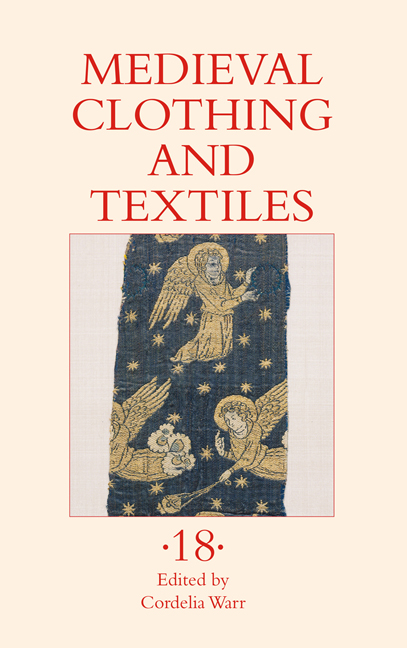Book contents
- Frontmatter
- Contents
- Illustrations
- Tables
- Contributors
- Preface
- 1 Linen Armour in the Frankish Countries: The Twelfth Century
- 2 Serial Production and Individualisation in Late Medieval Silk Weaving
- 3 The Trousseau of Isabella Bruce, Queen of Norway (The National Archives, Kew, DL 25/83)
- 4 Make and Create: The Craftswomen in the Salone Frescoes of the Palazzo della Ragione, Padua
- 5 Combs, Mirrors, and Other Female Beauty Bling in the Later Middle Ages
- 6 The Dividing Lines of Social Status in Sixteenth-Century Scottish Fashion
- Recent Books of Interest
- Author Index, Volumes 1–17
3 - The Trousseau of Isabella Bruce, Queen of Norway (The National Archives, Kew, DL 25/83)
Published online by Cambridge University Press: 10 May 2024
- Frontmatter
- Contents
- Illustrations
- Tables
- Contributors
- Preface
- 1 Linen Armour in the Frankish Countries: The Twelfth Century
- 2 Serial Production and Individualisation in Late Medieval Silk Weaving
- 3 The Trousseau of Isabella Bruce, Queen of Norway (The National Archives, Kew, DL 25/83)
- 4 Make and Create: The Craftswomen in the Salone Frescoes of the Palazzo della Ragione, Padua
- 5 Combs, Mirrors, and Other Female Beauty Bling in the Later Middle Ages
- 6 The Dividing Lines of Social Status in Sixteenth-Century Scottish Fashion
- Recent Books of Interest
- Author Index, Volumes 1–17
Summary
The inventory of the bridal goods of Isabella Bruce, Queen of Norway, drawn up on 25 September 1293 in Bergen, is considered an important document concerning Scottish-Norwegian relationships at the end of the thirteenth century and has been studied and cited mainly by historians. On closer examination of the text, however, a number of interesting remarks can also be made on the diverse items that made up the trousseau of the Scottish-born queen, their manufacture, quality, fabric, material, colours, and purpose. The colours and decorations of the bedding sets and soft furnishings in particular seem to be linked to significant heraldic figures.
For this article, a palaeographic and linguistic analysis was carried out on a digital copy of the document. The findings contribute to an explanation for some problematic loci, which have led to a new identification of the author/scribe of the inventory and their origins.
The text shows a number of the linguistic features that have been identified in medieval British business documents. Additionally, the analysis sheds light on a couple of technical words found in the inventory whose interpretation is not clear (banker? was perhaps used as an adjective meaning “for the seats” and palees was perhaps a noun meaning “two-coloured vertical striped cloth”). The document also contains the Medieval Latin hapax phalereteca which might mean “a metal ornament similar to a phalera” or perhaps “a sort of lock similar to a phalera.”
HISTORICAL CONTEXT
After the loss of part of their overseas empire in the 1260s, the Norwegian kings sought to re-establish ties with the Scottish crown. This was accomplished in August 1281 through the wedding of Margaret, daughter of Alexander III of Scotland, and the young king, Eirikr II of Norway. Margaret was about six years older than her husband, who was about thirteen years old at that time. The marriage lasted less than two years: Margaret died giving birth to her only daughter, Margaret of Norway, probably on 9 April 1283. The Norwegian princess became the heir apparent to the Scottish throne after Alexander III's death, but she died on her way to Orkney in late September or early October 1290. As the heir of his late daughter, Eirikr took part, albeit without success, in the Great Cause that took place between 1290 and 1292 in order to choose a new king of Scots.
- Type
- Chapter
- Information
- Medieval Clothing and Textiles , pp. 73 - 98Publisher: Boydell & BrewerPrint publication year: 2024

